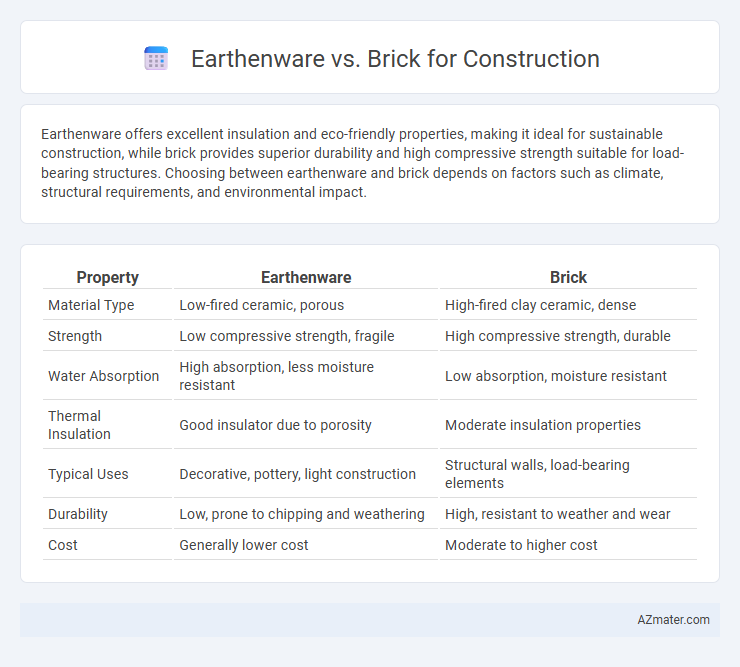Earthenware offers excellent insulation and eco-friendly properties, making it ideal for sustainable construction, while brick provides superior durability and high compressive strength suitable for load-bearing structures. Choosing between earthenware and brick depends on factors such as climate, structural requirements, and environmental impact.
Table of Comparison
| Property | Earthenware | Brick |
|---|---|---|
| Material Type | Low-fired ceramic, porous | High-fired clay ceramic, dense |
| Strength | Low compressive strength, fragile | High compressive strength, durable |
| Water Absorption | High absorption, less moisture resistant | Low absorption, moisture resistant |
| Thermal Insulation | Good insulator due to porosity | Moderate insulation properties |
| Typical Uses | Decorative, pottery, light construction | Structural walls, load-bearing elements |
| Durability | Low, prone to chipping and weathering | High, resistant to weather and wear |
| Cost | Generally lower cost | Moderate to higher cost |
Overview: Earthenware vs Brick in Construction
Earthenware in construction offers natural insulation and eco-friendly benefits due to its porous structure, making it ideal for sustainable building projects. Brick, composed primarily of fired clay, provides superior strength, durability, and fire resistance, establishing it as a preferred material for long-lasting structural applications. Comparing thermal performance, cost, and environmental impact helps determine the suitability of earthenware versus brick based on specific project requirements.
Material Composition and Properties
Earthenware consists primarily of clay, sand, and water, fired at lower temperatures resulting in a porous and less dense material ideal for non-load-bearing walls but vulnerable to moisture. Bricks are typically made from clay or shale, subjected to higher firing temperatures that create a denser, stronger material with enhanced compressive strength and durability suitable for structural elements. The material properties of bricks provide superior weather resistance and load support compared to earthenware, making bricks preferable for long-lasting construction projects.
Strength and Durability Comparison
Earthenware offers moderate compressive strength, making it suitable for non-load-bearing walls, but it is less durable and more susceptible to weathering compared to brick. Bricks, especially fired clay bricks, exhibit high compressive strength typically ranging from 7 to 50 MPa, providing superior structural integrity and long-term durability. The dense, vitrified nature of bricks enhances resistance to moisture, erosion, and mechanical stress, making them ideal for load-bearing structures in diverse environmental conditions.
Thermal Insulation Performance
Earthenware offers superior thermal insulation due to its natural porous structure, which helps regulate indoor temperatures by retaining heat in winter and maintaining coolness in summer. Bricks, especially fired clay bricks, provide moderate insulation but typically have higher thermal conductivity compared to earthenware, resulting in less energy efficiency. Choosing earthenware can enhance passive temperature control and reduce the need for artificial heating and cooling systems in construction projects.
Moisture Resistance and Weathering
Earthenware offers moderate moisture resistance but tends to absorb water, making it susceptible to weathering and structural weakening over time if not properly sealed. Brick, especially fired clay bricks, provides superior moisture resistance due to its dense composition, reducing water absorption and enhancing durability against weathering. This makes brick a preferred material in construction for environments exposed to heavy rainfall or harsh weather conditions.
Cost Analysis: Earthenware vs Brick
Earthenware offers a cost-effective alternative to traditional brick in construction due to lower material and manufacturing expenses, as it often utilizes locally sourced clay with minimal processing. Brick construction, while typically more expensive upfront, provides greater durability and lower maintenance costs over time, potentially offsetting initial investments. Evaluating long-term expenses, including labor, production energy, and insulation efficiency, is crucial for accurate cost analysis between earthenware and brick materials.
Environmental Impact and Sustainability
Earthenware and brick differ significantly in environmental impact and sustainability, with earthenware exhibiting lower embodied energy due to minimal processing and local material sourcing. Bricks, often fired at high temperatures, result in increased carbon emissions and energy consumption during production, contributing to a substantial environmental footprint. Earthenware's biodegradability and potential for reuse enhance its sustainability profile, whereas traditional bricks, while durable, present challenges in recyclability and often occupy landfill space after demolition.
Aesthetic and Design Flexibility
Earthenware offers a warm, natural aesthetic with textured, earthy tones that enhance rustic and traditional designs, while bricks provide a more uniform and versatile appearance suitable for both modern and classic architectural styles. The malleability of earthenware allows for custom shapes and intricate patterns, granting architects greater creative freedom in facade detailing. Brick's modular nature facilitates consistent structural patterns and clean lines, making it ideal for designs requiring precision and repetition.
Construction Techniques and Practicality
Earthenware in construction utilizes clay-based materials that are molded and sun-dried or kiln-fired, offering natural insulation and eco-friendliness, while bricks are manufactured by baking clay or shale at high temperatures to produce strong, uniform blocks suitable for load-bearing walls. Earthenware techniques require careful moisture control and are often applied in regions with dry climates to prevent structural damage, whereas brick construction involves standardized sizes and mortar for rapid assembly and enhanced durability. Practical application of earthenware favors thermal regulation and sustainability, whereas bricks provide higher compressive strength and greater resistance to weathering, making them ideal for long-term structural stability.
Best Applications: Choosing the Right Material
Earthenware is best suited for decorative or low-load applications due to its porous nature and aesthetic appeal, making it ideal for garden pots, tiles, and artisan walls. Brick, with higher compressive strength and durability, excels in structural construction such as residential buildings, load-bearing walls, and pavements. Selecting the right material hinges on assessing factors like moisture resistance, structural requirements, and environmental conditions to ensure longevity and performance.

Infographic: Earthenware vs Brick for Construction
 azmater.com
azmater.com